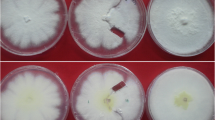Abstract
Twelve isolates of Microsporum equinum and nine monoascospore cultures of Nannizzia otae were studied on Sabouraud dextrose agar, polished rice grain, and on Pablum cereal agar for their gross morphology and micromorphology. The urease activity of each isolate was determined on Christensen's urea broth, and the in vitro hair perforation test was performed according to Ajello and Georg's technique. The 12 M. equinum isolates were paired with nine tester strains of N. otae (108 crosses) and with five M. canis isolates that were nonfertile with N. otae (60 crosses). The M. equinum isolates were also paired with each other in all possible combinations (78 crosses) on soil-hair medium, Pablum cereal agar, and oatmeal salts agar.
Whereas most of the macroconidia produced by the M. equinum isolates were smaller than those of N. otae, some were in the size range of the latter species. Both species hydrolyzed urea within 8 to 14 days. Although N. otae isolates perforated hair consistently, none of the M. equinum isolates perforated hair in vitro. The crosses between N. otae and M. equinum cultures, between isolates of M. canis (that were incompatible with N. otae) and the isolates of M. equinum, and between M. equinum isolates among themselves were nonreactive. These differences strongly support the view that M. equinum is a distinct species and should not be treated as a synonym of M. canis (N. otae).
Similar content being viewed by others
References
Ainsworth, G.C. & P.K.C. Austwick. 1973. Fungal Diseas of Animals. Commonwealth Agricultural Bureaux, Farnham Royal, Slough, England, pp. 10–36.
Ajello, L. 1968. A taxonomic review of the dermathophytes and related species. Sabouraudia 6: 147–159.
Ajello, L. & L.K. Georg. 1957. In vitro hail cultures for differentiating between atypical isolates of Trichophyton mentagrophytes and Trichophyton rubrum. Mycopath. et Mycol. Appl. 8: 3–17.
Alteras, I. & A. Avram. 1963. Consideratii asupra evolutiei dermatomicozelor pe 10 ani (1952–1961). Derm. Vener. Bucurest 8: 41–48.
Balbanov, V. 1959. Cultural-morphological, clinical and taxonomical studies of Microsporum in Bulgaria. Nauch. Trud. V.M.I., Sofya, 6: 71–89.
Batte, E.G. & W.S. Miller. 1953. Ringworm of horses and its control. J. Am. Vet. Med. Assoc. 123: 111–114.
Bergner, K. 1942. Microsporum equinum und Achorion gypseum als Erreger von Flechtenerkrankungen bei Pferden. Z. Infektkr. Haustiere 8: 121–147.
Brocq-Rousseu, D., A. Urbain & J. Barotte. 1927. Etude des teignes du cheval et de l'immunite dans les teignes experimentales. Ann. Inst. Pasteur, Paris 41: 513–553.
Conant, N.F. 1936. Studies in the genus Microsporum. Arch. Dermatol. Syphilol. 33: 665–683.
Conant, N.F. 1941. A statistical analysis of spore size in the genus Microsporum. J. Invest. Dermatol. 4: 265–278.
Dekeyser, J., L. Delcambe & and D. Thienpont. 1960. Activite therapeutique de l'iturine et du chinsol sur le teigne du cheval a Microsporum equinum. Bull. Epiz. Dis. Afr. 8: 279–288.
Dowding, E.S. & H. Orr. 1939. The dermatophyte Microsporum lanosum. Mycologia 31: 76–92.
Georg, L.K., W. Kaplan & L.B. Camp. 1957. Trichophyton equinum- a reevaluation of its taxonomic status. J. Invest. Dermatol. 29: 27–37.
Georg, L.K., W. Kaplan & L.B. Camp. 1957. Equine ringworm with special reference to Trichophyton equinum. Am. J. Vet. Res. 18: 798–810.
Hasegawa, A. & K. Usui. 1975. Nannizzia otae sp. nov., the perfect state of Microsporum canis Bodin. Jpn. J. Med. Mycol. 16: 148–153.
Lindqvist, K. 1960. Ringworms hos husdyr i Norge. Nord. Vet. Med. 12: 21–28.
Medvedeva, E.A. 1964. O mikrosporii volosistol chasti golovy, obuslovlennoi Microsporum equinum. Vestn. Derm Vener. 38: 25–26.
Neefs & Gillain. 1931. Contribution a l'etude de la teigne. Ann. Med. Vet. 76: 193–209.
O'Grady, K.J., M.P. Englisch & R.P. Warin. 1972. Microsporum equinum infection of the scalp in an adult. Brit. J. Dermatol. 86: 175–176.
Otceasek, M., K. Krivanee, J. Dvorak, J. Kamarek & A. Cerna. 1975. Microsporum equinum als einet dermatophytose des Pferdes. Zentralblatt für Veterinarmedizin 22: 833–841.
Padhye, A.A. 1969. Thermotolerance of Chrysosporium tropicum differentiates it from C. keratinophilum. Mycologia 61: 1162–1164.
Padhye, A.A., A.S. Sekhon & J.W. Carmichael. 1973. Ascocarp production by Nannizzia and Arthroderma on keratinous and non-keratinous media. Sabouraudia 11: 109–114.
Padhye, A.A. & L. Ajello. 1977. The taxonomic status of the hedgehog fungus Trichophyton erinacei. Sabouraudia 15: 103–114.
Pallaske, G. 1944. Die Hautkrankheiten des Pferdes und ihre Bekämpfung. Mitt. Landu. Berl. 15: 338–340.
Pepin, G.A. & P.K.C. Austwick. 1968. Skin diseases of domestic animals II. — Skin diseases mycological origin. Vet. Rec. 82: 208–214.
Petrovich, S.V. 1975. Vozbuditeli dermatomikozov loshadei. Veterinariya Moscow, U.S.S.R. 10: 49–51.
Philpot, C.M. 1977. The use of nutritional tests for the differentiation of dermatophytes. Sabouraudia 15: 141–150.
Spesivtzeva, N.A. 1957. Forty years of veterinary mycology, J. Agri. Sci., Moscow 34: 37–43.
Weitzman, I. & A.A. Padhye. 1978. Mating behaviour of Nannizia otae (=Microsporum canis). Mycopathologia 64: 17–22.
Weitzman, I. & M. Silva-Hutner. 1967. Non-keratinous agar media as substrates for the ascigerous state in certain members of the Gymnoascaceae pathogenic to man and animals. Sabouraudia 5:335–340.
Author information
Authors and Affiliations
Rights and permissions
About this article
Cite this article
Padhye, A.A., Weitzman, I. & Ajello, L. Mating behaviour of Microsporum equinum with Nannizzia otae. Mycopathologia 69, 87–90 (1979). https://doi.org/10.1007/BF00428607
Issue Date:
DOI: https://doi.org/10.1007/BF00428607




